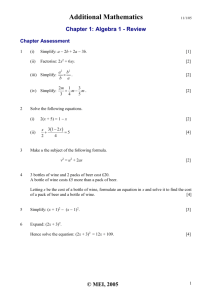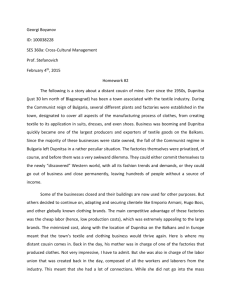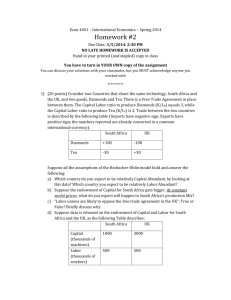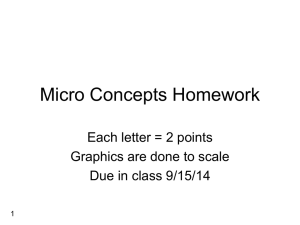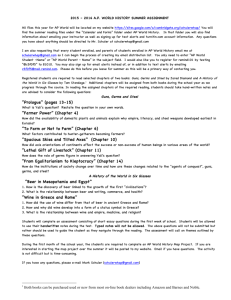International Trade Problem Set 1
advertisement
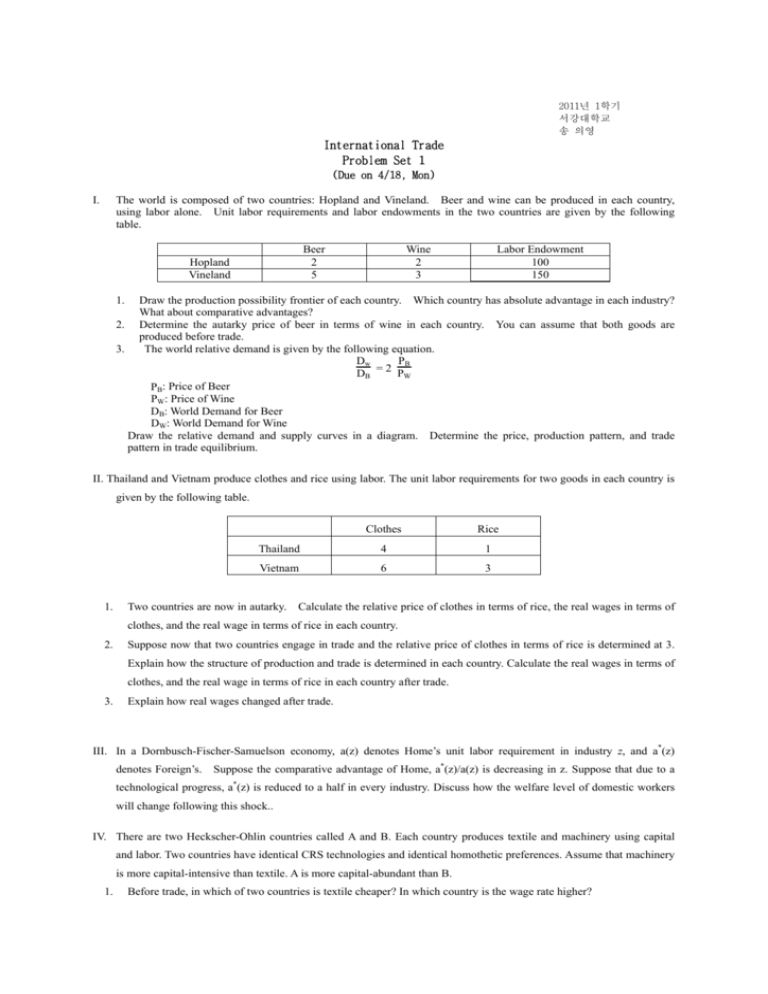
2011년 1학기 서강대학교 송 의영 International Trade Problem Set 1 (Due on 4/18, Mon) I. The world is composed of two countries: Hopland and Vineland. Beer and wine can be produced in each country, using labor alone. Unit labor requirements and labor endowments in the two countries are given by the following table. Beer 2 5 Hopland Vineland Wine 2 3 Labor Endowment 100 150 1. Draw the production possibility frontier of each country. Which country has absolute advantage in each industry? What about comparative advantages? 2. Determine the autarky price of beer in terms of wine in each country. You can assume that both goods are produced before trade. 3. The world relative demand is given by the following equation. PB Dw DB = 2 PW PB: Price of Beer PW: Price of Wine DB: World Demand for Beer DW: World Demand for Wine Draw the relative demand and supply curves in a diagram. Determine the price, production pattern, and trade pattern in trade equilibrium. II. Thailand and Vietnam produce clothes and rice using labor. The unit labor requirements for two goods in each country is given by the following table. 1. Clothes Rice Thailand 4 1 Vietnam 6 3 Two countries are now in autarky. Calculate the relative price of clothes in terms of rice, the real wages in terms of clothes, and the real wage in terms of rice in each country. 2. Suppose now that two countries engage in trade and the relative price of clothes in terms of rice is determined at 3. Explain how the structure of production and trade is determined in each country. Calculate the real wages in terms of clothes, and the real wage in terms of rice in each country after trade. 3. Explain how real wages changed after trade. III. In a Dornbusch-Fischer-Samuelson economy, a(z) denotes Home’s unit labor requirement in industry z, and a*(z) denotes Foreign’s. Suppose the comparative advantage of Home, a*(z)/a(z) is decreasing in z. Suppose that due to a technological progress, a*(z) is reduced to a half in every industry. Discuss how the welfare level of domestic workers will change following this shock.. IV. There are two Heckscher-Ohlin countries called A and B. Each country produces textile and machinery using capital and labor. Two countries have identical CRS technologies and identical homothetic preferences. Assume that machinery is more capital-intensive than textile. A is more capital-abundant than B. 1. Before trade, in which of two countries is textile cheaper? In which country is the wage rate higher? 2. Two countries trade. A big earthquake in B destroyed capital, but hurt no worker. Describe how this disaster affects the relative price of textile in the world market. V. Countries H and F produce X and Y using L and K. Two countries have CRS technologies given by the following production functions. H: QX = F(LX, KX), QY = G(LY, KY). F: QX = 2 F(LX, KX), QY = 2 G(LY, KY). 1. How the unit cost function for X would differ between two countries? 2. Suppose each country produces both goods and the prices of goods are identical in two countries. Using a single Mussa diagram, explain how W and R will be determined in each country. Does factor price equalization holds? VI. A Heckscher-Ohlin economy produces capital-intensive automobiles (A) and labor-intensive textiles (T). The economy produces both goods and the prices of two goods are given. Suppose K and L increases such that dK/dL is equal to the capital-intensity in the A industry. How will the production of A and T change? VII. Countries H and F produce X and Y using L and K. Two countries have identical CRS technologies and identical homothetic preferences. The factor endowments of two countries are given by the following. K = 30, L = 10, K* = 50, L* = 20. Suppose that factor prices and the resource allocation in the integrated economy are given by the following R =0.5, _ KX = 40, _ LX = 10, W = 1, _ KY = 40, _ LY = 20. Calculate the factor content of exports and imports of country H when two countries can freely trade X and Y.

